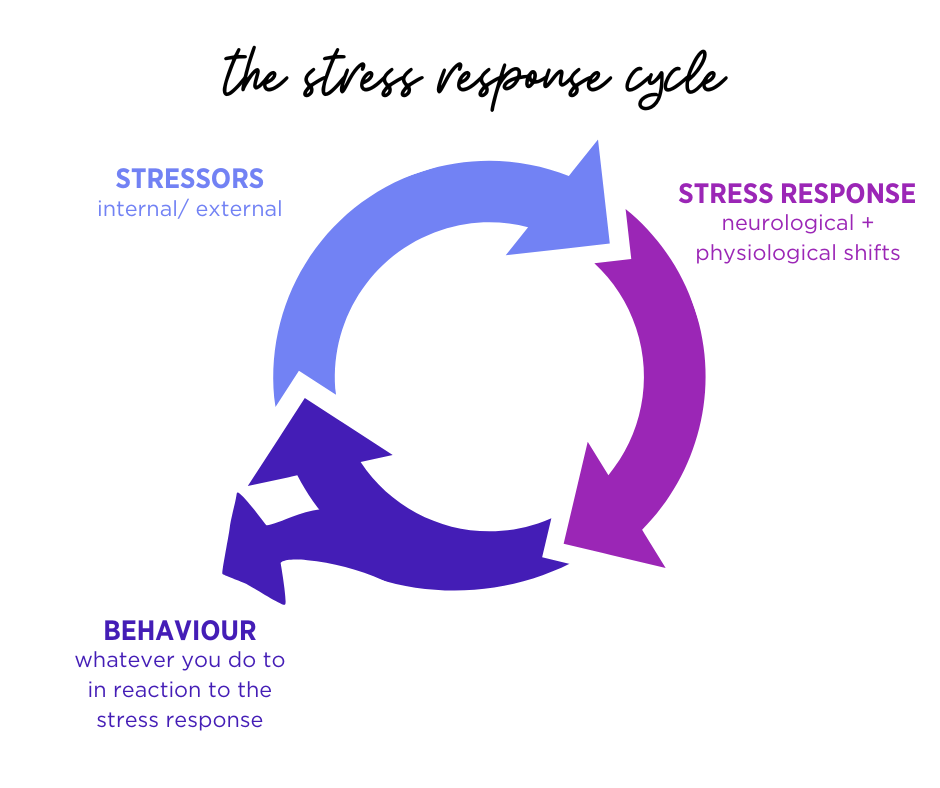What if "stress management" misses the mark?
A new perspective on stress that might change your life
This month our focus is STRESS - the impact on our body-mind, what we can do about it, and (most importantly) how we can manage/ respond in really functional (read: real life friendly) ways.
Week 1 we explored the background and I introduced you to the idea of a "stress response cycle" (an idea from the fabulous book "Burnout" By Dr. Emily Nagoski and Dr. Amelia Nagoski (yes they're sisters, twins actually!).
I've included the image below of the "stress response cycle" from last week, because this concept is the reference point for this week's topic!
This week, we're going to dive into STRESSORS (internal and external).
More specifically we're going to explore what our individual (and possibly collective) STRESSORS are, so we can work towards an ACTION plan to reduce the INPUT to the cycle.
We need to go upstream
When I think about exploring STRESSORS I think about this profound quote from Bishop Desmond Tutu:
"There comes a point where we need to stop just pulling people out of the river. We need to go upstream and find out why they're falling in."
This exploration of STRESSORS is about “going upstream” to find out why we're so stressed. Because understanding “why we’re falling in” is vital to our ability to manifest change (and potentially reducing our stress-load).
What’s in your bucket?
One metaphor that might help this concept land is the notion of a stress bucket.
(this is not the "ohhh that was bucket filling" kinda bucket, this is a different bucket)
In this bucket are ALL of the factors that contribute to your stress (aka "Stressors"). You might think of them as individual layers of fluid filling your bucket. If your STRESS bucket is really full from a multitude of stressors, then you're more likely to OVERFLOW when "one more thing" happens (because, #life).
By pro-actively exploring what's in your bucket (and then considering how you might decrease your "fill line") you potentially create more capacity to cope when life happens.
And it all begins with reflection and awareness, so...
What's stressing YOU?
One of my favourite tools to get a stress management "pulse check" is an exercise called the 4D's. It's a process I share with clients who are exploring their stress levels so they can move from struggling or surviving to thriving.
What I like about this process is it can really help you zoom out and get some perspective (sometimes we can't see what we can't see).
By setting aside some time to explore a process like this you might gain insight into something that is filling your STRESS bucket that you actually have some influence over (and thus can do something about).
As you're exploring this - consider both external stressors (like chores, work, parenting, health conditions/ illness/ injury, relationships, politics, world events, etc.) and internal stressors (ex. chronic worry thoughts, inner critic, negative body image, food noise/ eating challenges, anxiety, depression, other mental health challenges, feelings about politics and world events, etc.).
Reminder: this isn't about finding some magical solution to "manage" all the things....this process is about identifying and considering what you (really) DO have some agency to change (and making some tweaks...realistically).
Have a look at the process outlined in this resource!
Again, the goal isn't an empty bucket. That's not realistic. The goal is to reduce the level in the bucket, so you have a bit of "wiggle room" for real life.
Next week we'll be exploring how we RESPOND when "real life" happens (aka...what do we do to navigate stress in a way that reduces the costs/ impact on our body-mind!).
Onward in thriving,
Gillian
PS. Is there someone else in your life who might benefit from exploring this? Consider inviting them to explore this with you (BONUS: you have a buddy for accountability and support!). Share this article with them!







This bucket analogy is so great for my monkey mind. I love the visuals that you supply. I know for me that wording and having to read topics over and over for understanding brings so much judgement of self and visuals are such a great tool to help quieten that and notice.